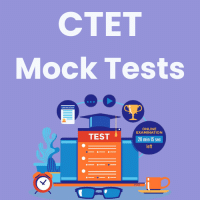CTET & State TET Exam > CTET & State TET Questions > Which approach is most appropriate in educati...
Start Learning for Free
Which approach is most appropriate in education in the present context?
- a)Behaviouristic approach
- b)Constructivistic approach
- c)Structuralistic approach
- d)Humanistic approach
Correct answer is option 'B'. Can you explain this answer?
Verified Answer
Which approach is most appropriate in education in the present context...
The constructivistic approach is most appropriate in education in the present context.
View all questions of this test
Most Upvoted Answer
Which approach is most appropriate in education in the present context...
Understanding the Constructivistic Approach
The constructivistic approach to education emphasizes the active role of learners in constructing their own understanding and knowledge. This method aligns with contemporary educational needs more effectively than other approaches.
Key Features of the Constructivistic Approach:
- Active Learning: Students engage with material through exploration and collaboration, fostering a deeper understanding of concepts.
- Personalized Learning: Each learner constructs knowledge based on their experiences, allowing for diverse perspectives and outcomes.
- Critical Thinking: Encourages students to analyze, synthesize, and evaluate information, promoting higher-order thinking skills.
- Social Interaction: Learning is often collaborative, which helps build communication skills and teamwork.
Relevance in Today’s Context:
- Technological Integration: The approach allows for the use of technology to facilitate learning, as students can research and share knowledge using digital tools.
- Diverse Learning Environments: With globalization, classrooms are more diverse, and constructivism accommodates various cultural backgrounds, enhancing inclusivity.
- Adaptability: The changing landscape of knowledge requires students to adapt continuously; constructivism prepares them for lifelong learning.
Conclusion:
Given these attributes, the constructivistic approach is particularly suited to contemporary educational contexts. It fosters an engaging, relevant, and adaptable learning environment that prepares students for the complexities of the modern world. By prioritizing active participation and critical thinking, it cultivates not only knowledge but also essential skills for future success.
The constructivistic approach to education emphasizes the active role of learners in constructing their own understanding and knowledge. This method aligns with contemporary educational needs more effectively than other approaches.
Key Features of the Constructivistic Approach:
- Active Learning: Students engage with material through exploration and collaboration, fostering a deeper understanding of concepts.
- Personalized Learning: Each learner constructs knowledge based on their experiences, allowing for diverse perspectives and outcomes.
- Critical Thinking: Encourages students to analyze, synthesize, and evaluate information, promoting higher-order thinking skills.
- Social Interaction: Learning is often collaborative, which helps build communication skills and teamwork.
Relevance in Today’s Context:
- Technological Integration: The approach allows for the use of technology to facilitate learning, as students can research and share knowledge using digital tools.
- Diverse Learning Environments: With globalization, classrooms are more diverse, and constructivism accommodates various cultural backgrounds, enhancing inclusivity.
- Adaptability: The changing landscape of knowledge requires students to adapt continuously; constructivism prepares them for lifelong learning.
Conclusion:
Given these attributes, the constructivistic approach is particularly suited to contemporary educational contexts. It fosters an engaging, relevant, and adaptable learning environment that prepares students for the complexities of the modern world. By prioritizing active participation and critical thinking, it cultivates not only knowledge but also essential skills for future success.

|
Explore Courses for CTET & State TET exam
|

|
Question Description
Which approach is most appropriate in education in the present context?a)Behaviouristic approachb)Constructivistic approachc)Structuralistic approachd)Humanistic approachCorrect answer is option 'B'. Can you explain this answer? for CTET & State TET 2025 is part of CTET & State TET preparation. The Question and answers have been prepared according to the CTET & State TET exam syllabus. Information about Which approach is most appropriate in education in the present context?a)Behaviouristic approachb)Constructivistic approachc)Structuralistic approachd)Humanistic approachCorrect answer is option 'B'. Can you explain this answer? covers all topics & solutions for CTET & State TET 2025 Exam. Find important definitions, questions, meanings, examples, exercises and tests below for Which approach is most appropriate in education in the present context?a)Behaviouristic approachb)Constructivistic approachc)Structuralistic approachd)Humanistic approachCorrect answer is option 'B'. Can you explain this answer?.
Which approach is most appropriate in education in the present context?a)Behaviouristic approachb)Constructivistic approachc)Structuralistic approachd)Humanistic approachCorrect answer is option 'B'. Can you explain this answer? for CTET & State TET 2025 is part of CTET & State TET preparation. The Question and answers have been prepared according to the CTET & State TET exam syllabus. Information about Which approach is most appropriate in education in the present context?a)Behaviouristic approachb)Constructivistic approachc)Structuralistic approachd)Humanistic approachCorrect answer is option 'B'. Can you explain this answer? covers all topics & solutions for CTET & State TET 2025 Exam. Find important definitions, questions, meanings, examples, exercises and tests below for Which approach is most appropriate in education in the present context?a)Behaviouristic approachb)Constructivistic approachc)Structuralistic approachd)Humanistic approachCorrect answer is option 'B'. Can you explain this answer?.
Solutions for Which approach is most appropriate in education in the present context?a)Behaviouristic approachb)Constructivistic approachc)Structuralistic approachd)Humanistic approachCorrect answer is option 'B'. Can you explain this answer? in English & in Hindi are available as part of our courses for CTET & State TET.
Download more important topics, notes, lectures and mock test series for CTET & State TET Exam by signing up for free.
Here you can find the meaning of Which approach is most appropriate in education in the present context?a)Behaviouristic approachb)Constructivistic approachc)Structuralistic approachd)Humanistic approachCorrect answer is option 'B'. Can you explain this answer? defined & explained in the simplest way possible. Besides giving the explanation of
Which approach is most appropriate in education in the present context?a)Behaviouristic approachb)Constructivistic approachc)Structuralistic approachd)Humanistic approachCorrect answer is option 'B'. Can you explain this answer?, a detailed solution for Which approach is most appropriate in education in the present context?a)Behaviouristic approachb)Constructivistic approachc)Structuralistic approachd)Humanistic approachCorrect answer is option 'B'. Can you explain this answer? has been provided alongside types of Which approach is most appropriate in education in the present context?a)Behaviouristic approachb)Constructivistic approachc)Structuralistic approachd)Humanistic approachCorrect answer is option 'B'. Can you explain this answer? theory, EduRev gives you an
ample number of questions to practice Which approach is most appropriate in education in the present context?a)Behaviouristic approachb)Constructivistic approachc)Structuralistic approachd)Humanistic approachCorrect answer is option 'B'. Can you explain this answer? tests, examples and also practice CTET & State TET tests.

|
Explore Courses for CTET & State TET exam
|

|
Signup for Free!
Signup to see your scores go up within 7 days! Learn & Practice with 1000+ FREE Notes, Videos & Tests.


















